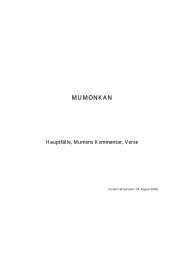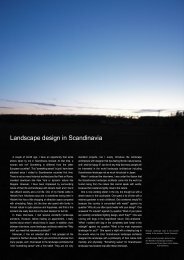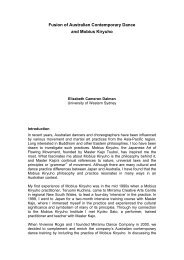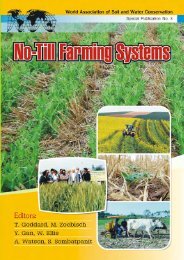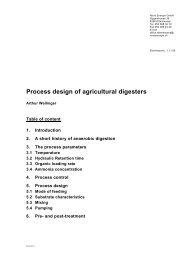Chatziathanassiou Artemios Center for Renewable Energy ... - Nifty
Chatziathanassiou Artemios Center for Renewable Energy ... - Nifty
Chatziathanassiou Artemios Center for Renewable Energy ... - Nifty
Create successful ePaper yourself
Turn your PDF publications into a flip-book with our unique Google optimized e-Paper software.
AD/Nett - Technical Summary - CRES<br />
CONSTRAINTS OF ANAEROBIC DIGESTION FOR ENERGY EXPLOITATION IN GREEK<br />
LIVESTOCK FARMING<br />
1. Introduction<br />
<strong>Chatziathanassiou</strong> <strong>Artemios</strong><br />
<strong>Center</strong> <strong>for</strong> <strong>Renewable</strong> <strong>Energy</strong> Sources<br />
19th. km Marathonos Av.<br />
GR-19009 Pikermi,<br />
GREECE<br />
Tel: +30 1 6039 900<br />
Fax: +30 1 6039 904,5/6038006<br />
E-mail: atemis@cres.gr<br />
Abstract: The main purpose of this work is the identification of the constraints hindering the<br />
anaerobic digestion (AD) of animal excrements <strong>for</strong> energy purposes in Greece. The theoretical<br />
methane potential generated from animal manure, comes up to 1,45 million m 3 /day with an<br />
energy potential 1,2 MTOE. The potential users <strong>for</strong> biogas production through AD would be<br />
focused on intensive livestock and especially on medium-large scale livestock units. A few<br />
ef<strong>for</strong>ts of biogas applications were made in the past through E.U. or National projects, but they<br />
have fallen into disuse. The AD <strong>for</strong> biogas production is seldom used <strong>for</strong> livestock waste<br />
treatment at the moment. The no-acceptability of biogas applications is attributed to a number<br />
of structural, financial, attitudinal and awareness constraints. The non-acquaintance of Greek<br />
farmers with the optimized use of biogas <strong>for</strong> energy production and the “lost credibility” of the<br />
biogas technology are some of the determinant factors. As well as the structural problems of the<br />
livestock sector and the high financing risks are some other gaps minimized biogas<br />
technologies approval. Finally, the environmental arguments of a biogas implementation are<br />
weak currently in Greece taking into account the global change and the reduction of land and<br />
water pollution. However, the penetration of AD schemes would be based on existing and<br />
coming financing means <strong>for</strong> the promotion of RES as well as on the awareness of Greek<br />
farmers by demonstration and promotion actions.<br />
In Greece, the agriculture contribution to the gross domestic product is only 12% and the livestock<br />
production represents the 30% of the gross agricultural income. The latter does not secures selfsufficiency<br />
of national market except <strong>for</strong> poultry farming, causing an annual import of livestock<br />
products more than 1.2 billion $ (7). Sheep, goats and lambs breeding represent the highest<br />
percentage of livestock (5) and its breeding is mainly shepherded. On the other hand, cattle and pig<br />
breeding is a promising agricultural activity and, moreover, it is structured with advanced production<br />
systems. Medium-large livestock units are located in current regions but the manure density is lower<br />
than it has noticed in Western Countries. A few “nitrate sensitive” sites have been defined at areas<br />
which are more affected from agricultural activities.<br />
The most common manure management method in medium-large livestock units in Greece is the<br />
disposal of liquid manure in anaerobic stabilization lagoons or the collection and de-watering of solid<br />
wastes on dung heaps. Anaerobic digestion (AD) <strong>for</strong> biogas production is seldom used <strong>for</strong> livestock<br />
waste treatment in Greece at the moment. This is mainly due to the lack of in<strong>for</strong>mation, proper<br />
infrastructure, state interest and waste management infrastructure.<br />
A few ef<strong>for</strong>ts of biogas applications were made in the past through EU or National projects, but they<br />
have fallen into disuse.<br />
1
AD/Nett - Technical Summary - CRES<br />
2. Potential resource<br />
On the basis of the EUROSTAT figures (1995) including all the kinds of breeding animals, the<br />
animal manure production is estimated up to 38,000 tonne/day. Taking into account that the largest<br />
portion of Greek livestock farming is not intensive, it is concluded that the available biogas potential<br />
would not include sheep, goats and lambs manure. This farming is mainly shepherded, so the manure<br />
produced is spread over the grazing land.<br />
The potential <strong>for</strong> biogas production through AD are likely to be focused on intensive livestock,<br />
especially on medium-large scale livestock units consisting of cattle, brood sows and poultry<br />
farming. The terms of medium and large scale livestock units were defined on an inventory of Greek<br />
Agricultural Bank (31/12/1995). Depending on these figures, the number of breeding animal heads<br />
and the medium-large scale units <strong>for</strong> cattle, pig and chicken breeding are presented in the following<br />
Table1:<br />
Table 1: Medium-large scale livestock units (Agricultural Bank of Greece, 1996).<br />
Category Number of Units Breeding animal heads<br />
Cattle 580 69,328<br />
Brood sows 448 105,793<br />
Chickens 361 20,042,050<br />
These units constitute the potential resource <strong>for</strong> biogas production under optimum conditions. It is<br />
estimated that AD of the manure produced by those units could result in a methane production<br />
almost 0,5 million m 3 /day and energy potential over of 400 kTOE (9). The volume of volatile solids,<br />
the estimated gas yield, in methane, and the energy potential per day are presented in the following<br />
Table 2:<br />
Table 2: Volume of volatile solids, estimated gas yield and energy potential per day<br />
of the medium-large scale livestock units in Greece.<br />
Category Volume of volatile<br />
solids per day (ton)<br />
Gas yield<br />
( 10 3 Nm 3 CH4)<br />
<strong>Energy</strong> Potential<br />
kTOE<br />
Cattle 291 195 155<br />
Brood sows 24 5 4<br />
Chickens 980 300 255<br />
Total 1,295 500 414<br />
3. Current treatment of livestock wastes<br />
In medium-large scale pig farms (>100 sows), the common practice of manure management is the<br />
collection in anaerobic lagoons after the collection mixing and mechanical separation. The discharged<br />
sludge is stored pit is considered as the main anaerobic treatment unit and the second as storage and<br />
currently as a treatment unit. Its operation acts as psychrophylic anaerobic digester open to the<br />
atmosphere (4). The main problem of this biological treatment system is the release of methane to<br />
the atmosphere contributing to global warming. As well as this, local nuisance problems have been<br />
created by the ammonia and other odour emissions during warm and dry weather periods.<br />
In cattle farms, solid manure is collected on impermeable plat<strong>for</strong>m where liquid from dung heap<br />
discharges in septic pool.<br />
In both cases and “vision of optimal conditions”, the disposal of liquid or solid manure is spread on<br />
farm land according to the “Codes of good agricultural practice <strong>for</strong> the protection of the waters from<br />
2
AD/Nett - Technical Summary - CRES<br />
nitrate pollution” (5). These guidelines define the timing of the disposal, <strong>for</strong> instance when the<br />
weather conditions are favourable <strong>for</strong> avoidance of run-off, or the retention time of slurry in<br />
anaerobic lagoons, even though the amounts of liquid manure <strong>for</strong> certain crops, etc.<br />
The poultry manure is collected dung heaps and is disposed on farm land after composting as it is a<br />
good fertilzer. The method and the compost process depends on the unit size, the bedding type and<br />
the objective of the breeding. Revenues are gained in the most poultry units.<br />
4. Historic perspective<br />
During the 1980s, few ef<strong>for</strong>ts <strong>for</strong> biogas applications were carried out in Greece. The Hellenic<br />
<strong>Center</strong> <strong>for</strong> Productivity (ELKEPA), a non-profit organization, had the main responsibility and the<br />
technical expertise of these ef<strong>for</strong>ts, usually in corporation with Agricultural University of Athens.<br />
The feedstock of the biogas applications was animal excrement and wastes from food processing<br />
industries such as olive oil mills. Some of them were demonstration projects that after enthusiasm<br />
and insurance of scientific support were abandoned and no longer operate. Examples of those<br />
projects are presented in Table 3:<br />
Table 3: Biogas demonstration projects out of commission today.<br />
Owner Place Feedstock Biogas<br />
production (m 3 /d)<br />
Digester<br />
Capacity (m 3 )<br />
ELVIK ABEE Trikala Swine Manure 300 402<br />
Vrakas-Paras Korinthos Swine Manure ---- ----<br />
Farm Corporation Kadanou Crete Olive oil mill waste 77 33<br />
EAS Naxou Naxos Milk factory wastes 330 500<br />
American Farm School (A.F.S.) – Biogas production through anaerobic treatment of farm waste.<br />
The AFS biogas plant is the oldest one in Greece. Initially the focus of its construction was directed<br />
to optimum biogas production. After a lot of technical and monitoring problems the emphasis shifted<br />
to the best environmental per<strong>for</strong>mance of the entire waste treatment and water reuse facility in which<br />
the biogas plant is one component (11). The anaerobic treatment of animal waste takes place in two<br />
anaerobic plug flow reactors in series. The liquid part goes through the anaerobic tanks and the solid<br />
part through a composting machine.<br />
The operational characteristics of the anaerobic treatment are summarized below:<br />
Liquid waste flow 30 m 3 /d<br />
Reactor temperature 37° C<br />
Total suspended solids TSS 22.3 kg/ m 3<br />
Volatile solids VS 17.5 kg/ m 3<br />
Biogas production 250 m 3 /d<br />
5. Constraints of AD <strong>for</strong> energy schemes in Greek livestock farming<br />
There are a lot of non technical barriers, which have affected negatively or have been continuing to<br />
steer public opinion away from the applicability of AD <strong>for</strong> energy exploitation in Greece.<br />
The reasons <strong>for</strong> low acceptability of biogas production in Greek livestock farming are presented in<br />
order of importance below. Awareness of them is necessary to overcome the current status in this<br />
type of RES in the near future and to plan operational energy schemes that could successfully<br />
promote AD applications in Greece<br />
3
AD/Nett - Technical Summary - CRES<br />
Non-acquaintance and structural problems<br />
The agricultural sector in Greece is dominated by small family owned enterprises which generally<br />
lack the resources and trained personnel to engage in long range planning or to implement<br />
technological developments. Thus, their capacity to institute efficiency improvements as well as<br />
waste treatment practices installing AD technologies is limited.<br />
In<strong>for</strong>mation transfer is a critical point of failure <strong>for</strong> farm owners, often lack the skills necessary to<br />
keep abreast of development in both the technological and policy areas. As a result, many<br />
opportunities to improve the per<strong>for</strong>mance of their livestock units are missed.<br />
Lack of credibility<br />
Past unsuccessful experience of biogas projects has led to the general idea that it is an unreliable<br />
technology, not suitable <strong>for</strong> use and sometimes no proven technology. However, the problems faced<br />
in most of those cases had nothing to do with digestion process or technology itself (digester,<br />
engine/generator) but with marginal aspects like:<br />
• Improper influent material or discontinuous feeding of the treatment process leading to<br />
discontinuous operation and varying thermal energy availability.<br />
• Lack of spare parts locally, crucial <strong>for</strong> the operation of a biogas plant (e.g. in American Farm<br />
School).<br />
• Inadequate planning, <strong>for</strong> instance, no study of sludge characteristics that later lead to blocked<br />
pipes or interruption of anaerobic process (e.g in the case of the large-scale piggery in Korinthos<br />
region).<br />
• Poor construction techniques, <strong>for</strong> instance resulting in substantial heat losses through the caps of<br />
digesters.<br />
• Inadequate resources (economic and human) resulting in problems in operation and inadequate<br />
maintenance programs (preventive cares/services not frequent enough).<br />
High risk of finance/investment:<br />
Biogas projects need heavy investment. Financing is there<strong>for</strong>e one of the key elements in order to<br />
promote biogas projects. The financing schemes must be adapted to this type of investments, with<br />
long pay-back periods, as the biogas projects will have long pay-back periods. The biogas plants are<br />
still very vulnerable from a commercial point of view, and the actual breakthrough is still uncertain.<br />
Failure is still a very real possibility even in countries with certain pioneering on biogas schemes such<br />
as Denmark and Germany (4). All of the these reasons and the national economic conditions, which<br />
discourage risk, do not favour any biogas scheme in Greek livestock farming. The obstacles <strong>for</strong> any<br />
investor could be summarized as follows:<br />
• high value of the discount rate (a promising reduction has been recently noticed) leading the net<br />
present value (NPV) and internal rate of return (IRR) on marginal levels <strong>for</strong> non-ambitious<br />
investments;<br />
• low electricity prices in Greece compared to other members of E.U., which make investments<br />
targeting energy savings unattractive;<br />
• lack of experience in strategy planning, investment realization and plant operation <strong>for</strong> all<br />
productive sectors (Local Authorities, Farm Associations and Livestock Unions) concerning<br />
biomass and especially biogas implementations;<br />
• lack of demonstration plants fully operational under Greek conditions.<br />
4
AD/Nett - Technical Summary - CRES<br />
In addition, the present restricted financial resources of the livestock farmers make them unable to<br />
invest <strong>for</strong> a project that can reach costs between 4,000 and 9,500 ECU per kW of electric power<br />
installed (13). All the above usually leads to medium/long pay-back periods, making those farmers<br />
who are interested hesitant on such investments.<br />
Weak environmental arguments<br />
Methane is an active greenhouse gas, with a Global Warming Potential (GWP) 23 times higher than<br />
that of CO2. Recovery techniques in manure management such as anaerobic digestion enable<br />
methane collection. The energy use of that eliminates completely the harmful effect of methane in the<br />
“global greenhouse effect”; the resulting CO2 emissions represent a much smaller contribution to the<br />
greenhouse effect than the one that the original methane would have had made.<br />
In terms of Kyoto protocol, the EU has made an commitment to reduce its greenhouse gases by 7%<br />
by 2010 in relation with 1990 emission levels. However, the Greek commitment is less strict: to limit<br />
greenhouse gases emissions increase to 25%. In 1995, the Greek agriculture contribution on methane<br />
release was 60% , but only 6% of that originated from manure management (7). On the other had,<br />
methane emissions from the enteric fermentation of ruminant livestock is the same with the European<br />
average (30%).<br />
The morphology of the Greek land is such that even when intensive agriculture is applied in some<br />
areas, the degree of intensification is much lower than the European dispersed and surrounded by<br />
vast quasi natural areas (hills, mountains, lakes, gulfs, etc.), that on one side are beneficial preserving<br />
biodiversity, on the other hand minimize problems causing insufficient treatment of livestock wastes.<br />
According to Nitrate Directive of the CEC<br />
91/676/EU, the Ministry <strong>for</strong> the Environment,<br />
Physical Planning & Public Works has<br />
determined four regions sensitive to nitrate<br />
concentration after measurements in surface and<br />
underground water. These regions – West and<br />
East Thessalia, Kopaida Plain, Argoliko Valley<br />
and Pinios Basin (Ilia) (Figure 1) – nitrate<br />
concentrations are higher than the limits set in<br />
the above Directive. Considering the existing<br />
strong agricultural activities (greenhouses,<br />
arable crops, etc.) and the low levels of livestock<br />
it would be safe to assume that the inorganic<br />
fertilizers as the main polluters there (6).<br />
Based on the above analysis, the argument of a<br />
biogas scheme <strong>for</strong> environmental benefits on<br />
“global change” and reduction of land and water<br />
pollution is not so strong currently in Greece.<br />
6. Perspectives of AD <strong>for</strong> energy schemes<br />
Figure 1: Distribution of sensitive nitrate areas in<br />
Greece<br />
(1) West & East Thessalia,<br />
(2) Kopaida Plain,<br />
(3) Argoliko Valley<br />
(4) Pinios Basin.<br />
The penetration of AD schemes in Greece is quite difficult due to the barriers outlined above. The<br />
existing means <strong>for</strong> financing the promotion of the investments on <strong>Renewable</strong> <strong>Energy</strong> Sources<br />
(Operational Programme <strong>for</strong> <strong>Energy</strong>-OPE/Ministry of Development, Law 2601/98/Ministry of<br />
Economics Affairs, European Programmes of Structural and Cohesion Funds) would be used <strong>for</strong><br />
energy exploitation projects, including biogas. These means have been already exploited <strong>for</strong> different<br />
types of RES and are expected to continue and even intensify in the near future (2000-2006). The<br />
5
AD/Nett - Technical Summary - CRES<br />
recent incentives <strong>for</strong> the promotion of RES, which are applicable to future biogas schemes, could be<br />
summarized as follows:<br />
• The Law 2244/94 regulates the issues connected to the production of electrical power from<br />
renewable sources of energy and conventional fuel. It is under revision now to be replaced by<br />
another one, which is draft according to new environment as its coming from the E.U. direction<br />
96/92/EC <strong>for</strong> the deregulation of power market.<br />
• Development Law 2601/98, which replace the Development Law 1892/90, improving incentives<br />
<strong>for</strong> investments on RES.<br />
• Joint Ministerial Decision (Ministry <strong>for</strong> Development, Ministry <strong>for</strong> Environment, Physical<br />
Planning and Public Works and Ministry of Economic Affairs) <strong>for</strong> the promotion of RES and the<br />
reduction of emissions CO2, which has been in effect since 1997.<br />
• Joint Ministerial Decision <strong>for</strong> the management of the solid wastes and the planning of landfill sites.<br />
<strong>Energy</strong> exploitation is the latest priority.<br />
The European Union target to increase the average of bioenergy from 45 million TOE (1995) to 135<br />
million TOE (2010), as is described in the White Paper <strong>for</strong> the promotion of <strong>Renewable</strong> <strong>Energy</strong><br />
Sources in Europe, must be also mentioned as a potential driving <strong>for</strong>ce the development of biogas<br />
schemes.<br />
In Europe the most commercial and technically mature anaerobic digestion systems are those<br />
designed <strong>for</strong> the digestion of animal manure, both on and off-farm as well as <strong>for</strong> co-digestion of<br />
animal manure and residues from slaughter houses, breweries and a wide range of other foodprocessing<br />
industries. In Greece, biogas applications will have more chance <strong>for</strong> success when there<br />
is a combination of by-products from cheese factories, oil olive mills, etc. with animal excrement.<br />
Livestock units that incorporate the whole chain of production, <strong>for</strong> instance slaughter, trade feeding<br />
stuffs, etc. would be potential investors <strong>for</strong> single biogas plants. The installation and operation of codigested<br />
biogas plants is a very promising alternative as has been shown from similar cases in<br />
Sweden, Denmark, Holland and Germany. However, the high investment cost, the Greek countryside<br />
morphology and the required strength cooperation of local productive sectors, makes this solution<br />
questionable <strong>for</strong> Greece <strong>for</strong> the time being.<br />
8. References<br />
1. Agricultural Bank of Greece. Directorate Livestock Production – Data from census in<br />
31/12/1995.<br />
2. <strong>Chatziathanassiou</strong>, A. and Panoutsou, K. (1998). Second intermediate year report of AD/Nett<br />
European Project, Co FAIR CT97 2083, CRES.<br />
3. EUROSTAT (1997). Agricultural Statistical Yearbook.<br />
4. Georgakakis, D. and Bicudo, J.R. (1999). “Anaerobic lagoon design and operation in swine<br />
facilities in Greece and in USA”. In the proceedings of the Ag<strong>Energy</strong> ’99 Conference, titled<br />
“<strong>Energy</strong> and Agriculture towards the Third Millennium”, Athens 2-5 June 1999, p. 374-381.<br />
5. Greek Democracy, Ministry of Agriculture (1994). “Codes of good agricultural practice <strong>for</strong> the<br />
protection of the waters from nitrate pollution”. Athens (in Greek).<br />
6
AD/Nett - Technical Summary - CRES<br />
6. Greek Democracy, Ministry <strong>for</strong> the Environment, Physical Planning & Public Works,<br />
Environmental Planning Directorate, Water department (1999). Network <strong>for</strong> the water<br />
protection of nitrate pollution. Athens (in Greek).<br />
7. Greek Democracy, Ministry <strong>for</strong> the Environment, Physical Planning & Public Works,<br />
Environmental Planning Directorate (1997). “2 nd National Communication to the United Nations<br />
Framework Convention on CLIMATE CHANGE. Review of the Greek National Action Plan <strong>for</strong><br />
the Abatement of CO2 and other Greenhouse Gases Emissions” Athens.<br />
8. Holm-Nielsen, J.B. and Seadi, A.T. (1998). “Danish experience concerning the advantage of the<br />
integrated system of biogas production, environmental protection and agricultural production”.<br />
In the proceedings of the ALTENER Workshop titled “<strong>Energy</strong> Exploitation of Biogas -<br />
Possibilities and Applications”, Thessaloniki, November 1998, CRES.<br />
9. Loehr, R.C. (1984). Pollution control <strong>for</strong> Agriculture (2 nd Ed.). Academic Press Inc., New York,<br />
p. 72-81.<br />
10. Nanou-Gianarou, A., Andreadakis, A. and Lazarou, A. (1999). Pollution of the water resources<br />
in Greece due to agricultural activities. In the proceedings of the 6o International Conference<br />
titled “Environment Science and Technology”. Pithagorio Samou, 30/8-2/9/1999, p. 26-33 (in<br />
Greeks).<br />
11. Nikolaidis, D. (1998). “Biogas production from agro-industrial wastes. Thessalonica<br />
Agricultural and Industrial Institute”. In the proceedings of the ALTENER Workshop in<br />
Thessaloniki titled “<strong>Energy</strong> Exploitation of Biogas - Possibilities and Applications”, November<br />
1998, CRES.<br />
12. Plitas F. (1995). “The Greek Livestock in E.U.” Modernized Livestock, Greek Magazine,<br />
Vol.12, 1995, Athens, p. 4-15.<br />
13. U.K., ETSU (1997). Anaerobic Digestion of farm and food processing residues. Good practice<br />
guidelines.<br />
7




